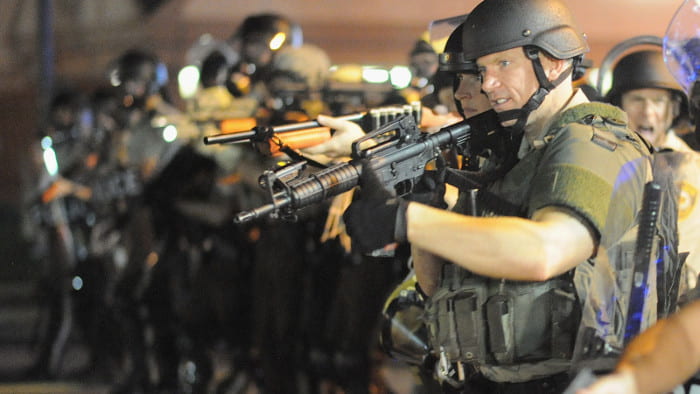By JARED THOMPSON – STAFF WRITER
In the aftermath of the events that transpired in Ferguson, Mo. in Aug. 2014, the county was thrown back into the midst of a debate concerning police brutality and the militarization of police. However, Americans are not strangers to this sort of debate. Rodney King’s assault sent Los Angeles—and the country—back to debating this issue in 1992, and the efforts of Daryl Gates, longtime chief of the Los Angeles Police Department, and others to create Special Weapons and Tactics (SWAT) teams arguably spawned the issues we now confront again.
The ever-present issue with these debates, however, is their heated rhetoric. Too often we see language like that espoused in the Body Count song “Cop Killer,” or ardent defense of police on the grounds that they are only seeking to protect us and provide for the general welfare. Neither characterization is very helpful in examining the actual issues at hand or the issues that have potential bearing on the loss of young life.
It is important to remember, however, that Department of Justice (DoJ) figures put the number of law enforcement personnel with general arrest powers employed by local and state agencies at approximately 765,000 in 2008, with more federal personnel employed on top of this figure. Generally speaking, it will be next to impossible to derive broad generalizations about the nature of police or police officers due to the sheer number of individual officers acting independently of each other in radically different environments and under dissimilar circumstances.
Fear of mischaracterization, however, must only make conversations proceed with caution and not stop them entirely.
To begin, we must confront the issue of the 1033 Program operated by the Department of Defense (DoD). The 1033 Program, which utilizes the tagline “from warfighter to crimefighter,” seeks to transfer excess DoD equipment to more than 17,000 federal and state law enforcement agencies. “Excess” carries with it an implication that this equipment is comprised of hand-me-downs, when in fact an ACLU report published in June 2014 stated that 36 percent of this equipment is actually new and includes things like automatic rifles, armored personnel carriers (APCs), and combat vests. This gifting of equipment spiked dramatically post-9/11 and now nearly $450 million of equipment was transferred through the program in 2013.
The consequences of this program are fairly self-evident: local agencies are now equipped with military-grade equipment without the same level of training as the military personnel for whom the equipment was originally designed. This can easily lead to misapplication of the equipment.
As a city councilmember from Keene, N.H. put it after their town was gifted a BearCat APC, “What red-blooded American cop isn’t going to be excited about getting a toy like this?”
When you are given something by the federal government, it comes with an implicit endorsement of using said item in the correct circumstances. However, without the requisite training we often turn on the news to see images of protestors being flashbanged or police taking aim with sniper rifles from vantage points atop APCs.
All of this is consistent with political rhetoric concerning “homegrown terrorism” in the post-9/11 law enforcement landscape. We are told that we must be ever vigilant against the threats of domestic terrorism and therefore our police must be given the necessary tools to combat it.
But let’s localize that logic. Imagine the town of Danville combating a domestic terrorist threat. Would it effectively combat it? Would you want it to? In what reasonable scenario would the Danville Police Department not be reinforced or replaced by better trained Federal Bureau of Investigation officers?
The process of gifting equipment seems to shift a burden onto local police agencies and signal to them that they should be ever-ready to combat a large domestic threat. I personally don’t believe this is reasonable to expect of local agencies, and it represents an inefficient shift in priorities.
The vast majority of my argument has focused on the militarization of police. Why not confront the raw numbers of police brutality and the cases of young black men being shot by white police officers?
The data to effectively argue points concerning the incidence of police brutality simply doesn’t exist. DoJ figures from 2006 say that roughly 7.5 percent of excessive force complaints were found to “have merit” while a 1998 Human Rights Watch report stated that the process of filing these complaints was “unnecessarily difficult and often intimidating” in the 14 precincts it examined. Oftentimes, police brutality goes unreported, which while it is a fairly self-evident problem in and of itself, it makes arguing whether or not the incidence of police brutality is a glaring problem a difficult venture.
Despite this quite unsatisfying access to information, there are some sparks of hope in what we certainly can agree is a necessary battle against abuses of power. Departing from the inaction of the Bush Administration, Obama pledged early in his administration to instruct the DoJ to crack down on brutality and abuses of power in 2011.
Has this been effective? We still see cases like Ferguson being highly publicized but without comprehensive statistics it is next to impossible to draw real conclusions about prevalence. Maybe in a more transparent world we can begin to have conversations about how police, those charged with making society safe from crime, can plague the very strata of society most in need of safekeeping.
